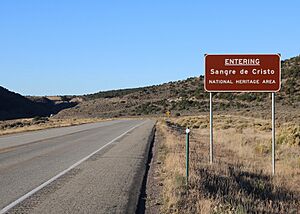Sangre de Cristo National Heritage Area facts for kids
The Sangre de Cristo National Heritage Area is a special place in south-central Colorado, USA. It's like a big outdoor museum that helps protect the history, nature, and cultures of the area. This heritage area includes the beautiful San Luis Valley and parts of the Sangre de Cristo Range mountains.
This region is unique because it blends influences from three main groups: Anglo-American settlers, Hispano-American people (who were some of the first European settlers in Colorado), and Native American tribes. It also covers parts of the upper Rio Grande river valley.
What Areas Does It Cover?
The Sangre de Cristo National Heritage Area is quite large! It includes all of Alamosa, Costilla, and Conejos counties. It also covers parts of Saguache and Rio Grande counties.
Inside this heritage area, you can find many other important natural and historical sites, such as:
- Great Sand Dunes National Park and Preserve: Famous for its giant sand dunes.
- Baca National Wildlife Refuge: A home for many wild animals.
- Sangre de Cristo Wilderness: A protected wild area in the mountains.
- South San Juan Wilderness: Another beautiful wilderness area.
- Monte Vista National Wildlife Refuge: A key spot for birds and other wildlife.
- Alamosa National Wildlife Refuge: More protected land for animals.
- The Medano-Zapata Ranch: A historic ranch.
- The Trujillo Homestead: A historic farm that is a National Historic Landmark.
Why Is Culture Important Here?
This area is very special for its history and culture. It overlaps with what some experts call the "Hispano Homeland." This refers to the unique Hispanic communities in the upper Rio Grande Valley and nearby mountain areas.
The Sangre de Cristo National Heritage Area was created to help protect and share the region's special cultures and natural beauty. For a long time, the San Luis Valley was quite isolated. This helped to preserve a unique local Spanish language and way of speaking. Many people living here today are descendants of the Hispanos, who were Spanish colonial settlers. They arrived in the 1800s and were the very first European settlers in Colorado.
The Sangre de Cristo National Heritage Area was officially established in 2009. This happened through a law called the Omnibus Public Land Management Act of 2009.


